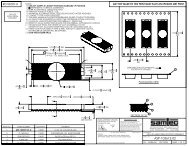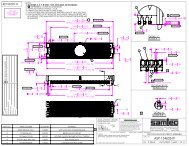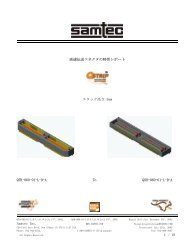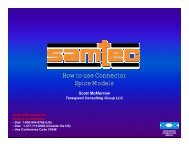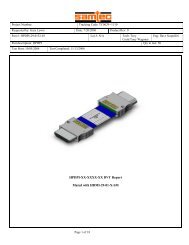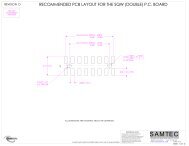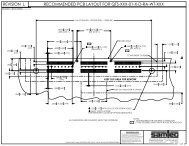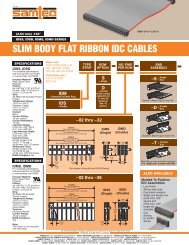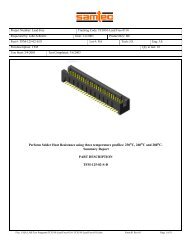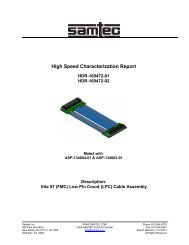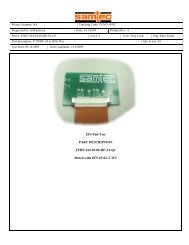You also want an ePaper? Increase the reach of your titles
YUMPU automatically turns print PDFs into web optimized ePapers that Google loves.
<strong>IBIS</strong> <strong>Connector</strong> <strong>Models</strong>:<br />
Facts vs. Fiction<br />
DesignCon 2006<br />
TecPreview<br />
Jim Nadolny<br />
Corey Kimble<br />
Slide 1<br />
DesignCon 2006<br />
<strong>IBIS</strong> <strong>Connector</strong> <strong>Models</strong>, Fact vs. Fiction
Outline<br />
• Background<br />
• <strong>Samtec</strong> Model Requests<br />
• Simulation Tools<br />
• <strong>Connector</strong> <strong>Models</strong><br />
– SPICE vs. <strong>IBIS</strong> vs. S-parameter<br />
• Syntax differences<br />
• Example connector<br />
• <strong>Connector</strong> analysis<br />
– PSPICE vs. Allegro PCB SI<br />
• Conclusion<br />
• Resources<br />
Slide 2<br />
DesignCon 2006<br />
<strong>IBIS</strong> <strong>Connector</strong> <strong>Models</strong>, Fact vs. Fiction
Background<br />
• High speed (>1 Gb/s) serial<br />
data is mainstream<br />
– PCI Express<br />
– Fibre Channel<br />
– XAUI<br />
• Analysis is required for<br />
– System timing (jitter)<br />
– Amplitude margin (eye<br />
opening)<br />
Slide 3<br />
DesignCon 2006<br />
<strong>IBIS</strong> <strong>Connector</strong> <strong>Models</strong>, Fact vs. Fiction
Background<br />
Tools<br />
– Cadence, Mentor, Synopsys, etc.<br />
– Analysis only as good as the models used<br />
– Need models for drivers, receivers and interconnect path<br />
– <strong>Connector</strong>s can be a dominant crosstalk and reflection<br />
mechanism in the interconnect path so “good”<br />
connector models are required<br />
– What syntax should be used for the connector model,<br />
and where do you get them?<br />
• To answer the syntax question, we need to review the<br />
simulation tools used for high speed digital analysis<br />
and look at what customers ask for…<br />
Slide 4<br />
DesignCon 2006<br />
<strong>IBIS</strong> <strong>Connector</strong> <strong>Models</strong>, Fact vs. Fiction
<strong>Samtec</strong> Model Requests<br />
<strong>Samtec</strong> Perspective<br />
– Emphasis is on customer service [easy]<br />
• we logged 1500 SI service requests in 2005<br />
– Requests are for SPICE, <strong>IBIS</strong> or S-parameter<br />
models<br />
– We have learned to ask a few more questions<br />
when a customer requests an “<strong>IBIS</strong> model”<br />
Slide 5<br />
DesignCon 2006<br />
<strong>IBIS</strong> <strong>Connector</strong> <strong>Models</strong>, Fact vs. Fiction
<strong>Samtec</strong> Model Requests<br />
<strong>Samtec</strong> Perspective<br />
– Customers request “<strong>IBIS</strong>” models<br />
– <strong>Samtec</strong> customers are using simulation tools that import<br />
<strong>IBIS</strong> models for drivers/receivers but do not import <strong>IBIS</strong> ICM<br />
connector models<br />
– When you dig deeper you find that customers are looking<br />
for models that import directly into their tools:<br />
• Mentor Graphics, HyperLynx, ICX/TAU<br />
• Cadence, Allegro PCB SI<br />
• This is not an endorsement for these tools, rather<br />
it is what our customer base is generally using (in<br />
addition to Synopsys HSPICE)<br />
Slide 6<br />
DesignCon 2006<br />
<strong>IBIS</strong> <strong>Connector</strong> <strong>Models</strong>, Fact vs. Fiction
<strong>Samtec</strong> Model Requests<br />
Information Required for a <strong>Samtec</strong> Model<br />
• What are the part numbers of the MATED connector?<br />
• What is the model structure needed? Single-line? Single<br />
differential pair? Multi-line?<br />
• What is the simulation tool that you are using?<br />
• Information on the performance requirements of your<br />
application<br />
– signal specification<br />
– wiring pattern<br />
Slide 7<br />
DesignCon 2006<br />
<strong>IBIS</strong> <strong>Connector</strong> <strong>Models</strong>, Fact vs. Fiction
Simulation Tools<br />
Mentor Graphics<br />
– HyperLynx GHz, EXT<br />
• Import models in .slm or .sp format (spice-like)<br />
– ICX/TAU<br />
• Import models in .mmf format or <strong>IBIS</strong> 4.1 EBD<br />
format<br />
– Note that EBD format is an RLC network useful for<br />
timing but not crosstalk<br />
– EBD is a “creative workaround” to obtain a<br />
connector model from an electrical board<br />
description<br />
Slide 8<br />
DesignCon 2006<br />
<strong>IBIS</strong> <strong>Connector</strong> <strong>Models</strong>, Fact vs. Fiction
Simulation Tools<br />
Cadence<br />
– Allegro PCB SI 210/230<br />
• Import models in .dml format (spice like)<br />
– format supports single line models (no crosstalk) or<br />
multi-line models (includes crosstalk)<br />
– Allegro PCB SI 630<br />
• Import models in .dml format or S-parameter<br />
format.<br />
Slide 9<br />
DesignCon 2006<br />
<strong>IBIS</strong> <strong>Connector</strong> <strong>Models</strong>, Fact vs. Fiction
<strong>Connector</strong> <strong>Models</strong><br />
• SPICE<br />
– .cir (PSpice)<br />
– .sp (HSPICE)<br />
• SPICE-like<br />
– .sp (ELDO)<br />
Minor syntax differences from SPICE<br />
– .dml (eSpice)<br />
• <strong>IBIS</strong><br />
– .icm<br />
Significant syntax differences from<br />
• <strong>IBIS</strong>–like<br />
SPICE, uses keywords<br />
– .mmf (ICX)<br />
• S-parameters<br />
Frequency<br />
– .s4p (Touchstone)<br />
domain representation<br />
(must be passive, causal)<br />
Slide 10<br />
DesignCon 2006<br />
<strong>IBIS</strong> <strong>Connector</strong> <strong>Models</strong>, Fact vs. Fiction
<strong>Connector</strong> <strong>Models</strong><br />
SPICE vs. <strong>IBIS</strong> syntax differences<br />
SPICE<br />
• Comments preceded by “*”<br />
• Subcircuit definition begins<br />
with .subckt and ends with<br />
.ends<br />
• Model elements connected<br />
to nodes<br />
• Comment<br />
– Developed for IC’s<br />
<strong>IBIS</strong> (ICM)<br />
• Comments preceded by “|”<br />
• Subcircuit definition begins<br />
with [Begin_ICM_Section]<br />
and ends with [End ICM<br />
Section]<br />
• Model elements are<br />
inductance and<br />
capacitance matrices<br />
• Syntax driven by keywords<br />
• Comment<br />
– Developed for connectors<br />
Slide 11<br />
DesignCon 2006<br />
<strong>IBIS</strong> <strong>Connector</strong> <strong>Models</strong>, Fact vs. Fiction
Example<br />
<strong>Samtec</strong> QTE/QSE <strong>Connector</strong><br />
• 0.8mm pitch<br />
• 5mm-30mm stacking height<br />
•
Example<br />
Available QTE/QSE <strong>Connector</strong> <strong>Models</strong><br />
All models represent the QTE/QSE 5mm stack height<br />
connector.<br />
• DM5_QTE_QSE.dml = Cadence DML ESPICE multi-line<br />
• DM5_QTE_QSE.sp = ELDO model for HyperLynx<br />
• slm_g_qte01_qse01.icm = <strong>IBIS</strong> ICM single-line general<br />
• MM5_QTE_QSE.MMF = Mentor Graphics ICX MMF<br />
format multi-line<br />
• MQTE1QSE1.mlm = SPICE multi-line<br />
We also can do single-line in DML, ELDO, and MMF<br />
Slide 13<br />
DesignCon 2006<br />
<strong>IBIS</strong> <strong>Connector</strong> <strong>Models</strong>, Fact vs. Fiction
<strong>Connector</strong> Analysis<br />
PSPICE vs. Allegro PCB SI<br />
Cadence Allegro PCB SI (.dml format) vs. Cadence<br />
PSPICE (.cir format)<br />
– perform connector analysis<br />
• crosstalk, impedance, input and output waveform<br />
– Compare results (sim. time, ease of analysis)<br />
– Use QTE/QSE 5mm model<br />
• multi-line model with 1:1 S/G ratio<br />
– Include footprint parasitics in the analysis<br />
– 100ps risetime source<br />
Slide 14<br />
DesignCon 2006<br />
<strong>IBIS</strong> <strong>Connector</strong> <strong>Models</strong>, Fact vs. Fiction
<strong>Connector</strong> Analysis<br />
PSPICE vs Allegro PCB SI<br />
3.00E-01<br />
PSPICE vs Allegro PCB SI<br />
2.50E-01<br />
Voltage (volts)<br />
2.00E-01<br />
1.50E-01<br />
1.00E-01<br />
5.00E-02<br />
Input Side of <strong>Connector</strong> Allegro PCB SI<br />
Input Side of <strong>Connector</strong> -PSPICE<br />
0.00E+00<br />
-5.00E-02<br />
0.0E+00<br />
5.0E-10<br />
1.0E-09<br />
time (s)<br />
1.5E-09<br />
2.0E-09<br />
2.5E-09<br />
Slide 15<br />
DesignCon 2006<br />
<strong>IBIS</strong> <strong>Connector</strong> <strong>Models</strong>, Fact vs. Fiction
<strong>Connector</strong> Analysis<br />
PSPICE vs. Allegro PCB SI<br />
3.00E-01<br />
PSPICE vs Allegro PCB SI<br />
2.50E-01<br />
Voltqage (volts)<br />
2.00E-01<br />
1.50E-01<br />
1.00E-01<br />
5.00E-02<br />
Output Side of <strong>Connector</strong> Allegro PCB SI<br />
Output Side of <strong>Connector</strong> -PSPICE<br />
0.00E+00<br />
-5.00E-02<br />
0.0E+00<br />
5.0E-10<br />
1.0E-09<br />
time (s)<br />
1.5E-09<br />
2.0E-09<br />
2.5E-09<br />
Slide 16<br />
DesignCon 2006<br />
<strong>IBIS</strong> <strong>Connector</strong> <strong>Models</strong>, Fact vs. Fiction
<strong>Connector</strong> Analysis<br />
PSPICE vs. Allegro PCB SI<br />
4.00E-03<br />
PSPICE vs Allegro PCB SI<br />
3.00E-03<br />
NEXT PSPICE<br />
NEXT Allegro PCB SI<br />
NEXT (v)<br />
2.00E-03<br />
1.00E-03<br />
0.00E+00<br />
-1.00E-03<br />
0.00E+00<br />
5.00E-10<br />
1.00E-09<br />
time (s)<br />
1.50E-09<br />
2.00E-09<br />
2.50E-09<br />
Slide 17<br />
DesignCon 2006<br />
<strong>IBIS</strong> <strong>Connector</strong> <strong>Models</strong>, Fact vs. Fiction
<strong>Connector</strong> Analysis<br />
PSPICE vs. Allegro PCB SI<br />
3.00E-03<br />
PSPICE vs Allegro PCB SI<br />
2.00E-03<br />
FEXT PSPICE<br />
FEXT Allegro PCB SI<br />
FEXT (v)<br />
1.00E-03<br />
0.00E+00<br />
-1.00E-03<br />
0.00E+00<br />
5.00E-10<br />
1.00E-09<br />
1.50E-09<br />
2.00E-09<br />
2.50E-09<br />
time (s)<br />
Slide 18<br />
DesignCon 2006<br />
<strong>IBIS</strong> <strong>Connector</strong> <strong>Models</strong>, Fact vs. Fiction
Analysis Results<br />
Runtimes<br />
• Allegro PCB SI – 1 minute 23 seconds<br />
• PSPICE – 50 seconds<br />
Ease of Use<br />
• PCB SI graphs buffer voltages, internal nodes not<br />
accessible<br />
• Required creative use of “ESpice” device for graphing<br />
and for 100 ps source<br />
Slide 19<br />
DesignCon 2006<br />
<strong>IBIS</strong> <strong>Connector</strong> <strong>Models</strong>, Fact vs. Fiction
Conclusion<br />
• <strong>IBIS</strong> connector models are well defined but are not<br />
widely incorporated into SI tools<br />
• Syntax changes are required to convert SPICE<br />
models into SPICE-like formats required by SI tools<br />
• <strong>Samtec</strong> has performed these syntax conversions so<br />
that connector models can be incorporated<br />
directly into SI tools.<br />
– Less work required by the customer [easy]<br />
– Equivalent performance regardless of tool used<br />
Slide 20<br />
DesignCon 2006<br />
<strong>IBIS</strong> <strong>Connector</strong> <strong>Models</strong>, Fact vs. Fiction
Resources<br />
• All <strong>Samtec</strong> connector models available at<br />
http://www.samtec.com<br />
• Information on <strong>IBIS</strong> models<br />
http://www.eda.org/pub/ibis/connector/<br />
• Translating SPICE models to .dml format for Cadence<br />
Allegro PCB SI<br />
http://www.cadence.com/community/allegro/pcb_si/tr.<br />
aspx?type=Modeling<br />
• Any SI questions? sig@samtec.com<br />
Slide 21<br />
DesignCon 2006<br />
<strong>IBIS</strong> <strong>Connector</strong> <strong>Models</strong>, Fact vs. Fiction
Acknowledgments<br />
• Kim Helliwell (consultant) performed the<br />
comparisons between PSPICE and Cadence<br />
Allegro PCB SI<br />
Slide 22<br />
DesignCon 2006<br />
<strong>IBIS</strong> <strong>Connector</strong> <strong>Models</strong>, Fact vs. Fiction



